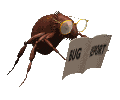
 |
Fleas |
DESCRIPTION
Adult - Adult fleas are brown, wingless, laterally compressed insects from 1 to 2.5 mm long.
Egg - Flea eggs are oval and about 0.5 mm long.
Larva - Flea larvae vary in length from 4 to 6 mm when mature and are slender, white, cylindrical and legless with 10 to 12 moderately long setae on each body segment. The pale brown head has no eyes.
Pupa - The pupa is shaped somewhat like the adult and develops in a white, oval, silken cocoon about 4 mm long which is often covered with sand, lint, or dust.
BIOLOGY.
Distribution - Fleas, as a group, are cosmopolitan in occurrence. They are commonly found in clothing, bedding or near areas where host animals sleep or in the fur of the host animal. Fleas spread through homes, buildings and yards.
Hosts - Practically all warm-blooded animals are fed upon by fleas. Each species of flea, however, usually feeds on a limited number of specific animals. Human fleas occasionally feed on swine and dogs. The oriental rat flea feeds primarily on commensal rodents but sometimes feeds on man.
Damage - Flea bites cause a persistent, annoying itch. Scratching the area of the bite causes the skin to be irritated. Some fleas, especially the oriental rat fleas, are capable of transmitting diseases such as endemic typhus and bubonic plague. Fortunately, such instances of disease transmission to humans are rare.
Life History -- Fleas may feed and breed throughout the year but development often slows during the winter months because of low temperatures. Females deposit eggs on the host a few at a time. Human fleas lay up to 400 eggs in their lifetime. Eggs usually fall off host animals and hatch in 2 to 14 days. Larvae generally feed on organic matter such as excrement from adult fleas and domestic animals. Immature fleas can develop indoors in carpeting and overstuffed furniture. After 1 to 5 weeks, larvae spin cocoons and pupate. Under favorable conditions, a new generation of adults emerges 1 to 3 weeks later. For some species, the fully developed adults remain in the cocoon until they are disturbed by specific environmental cues. Cat and dog fleas jump from their cocoons when carbon dioxide and vibrations signal the proximity of a host. Thus, homeowners returning from vacation may encounter a large number of hungry fleas. An entire life cycle may be completed in as few as 2 or 3 weeks, but several months to 2 years may elapse if conditions are unfavorable.
Adult fleas cannot breed or survive for extended periods of time without feeding on blood. The dog flea, for example, may live approximately 60 days without feeding. If fed, adults may survive for 230 days without another meal. Temperature of 19 to 20°C (65 to 70°F) and a humidity of about 70% are optimal for flea development.
CONTROL
Fleas are controlled by treating animals, building interiors, animal quarters, and/or yards. The specific insecticide to be used depends on what type of animal is infested and whether the infestation occurs indoors or outdoors. Because flea larvae feed on organic matter, sanitation should be practiced scrupulously to discourage flea development indoors.
| Phone 3861-5857 | Mobile 0403-949098
|
| Licence No. | PMT-O-10363 |  |
|
| Q.B.S.A No. | 1066314 | ||
| S.I.C. No | 0247341 |